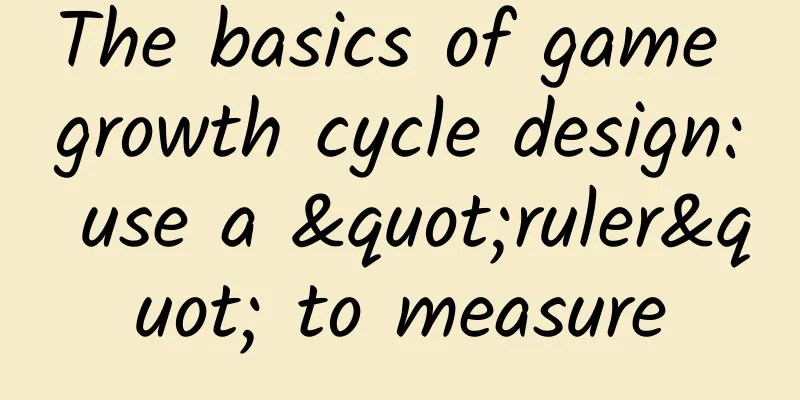The basics of game growth cycle design: use a "ruler" to measure

|
Text/Chen Han Talk about the basis of numerical balance: the ruler method Set a basic conversion scale, and then use this scale to derive the combat value system and economic value system for each player's growth stage in the game. Take RPG as an example When a level 1 warrior kills a level 1 slime, he loses 10 HP points on average and gains 1 copper coin on average. (Whether using the addition attack and defense calculation formula system or the multiplication attack and defense calculation formula system, the above results should be obtained. In other words, you can find a way to adjust the formula to achieve such a result.) So what is the conversion between HP and copper coins? We need to come up with a standard: a small blood bottle that restores 20 points of HP is set at 1 copper coin. In essence, the player gets a profit of 0.5 copper coins each time he kills a slime. Why you want to give players a profit is your "design intention". If the price of a small blood bottle that restores 20 points of HP is 2 copper coins, then the player will not make any profit. If the price is 3 copper coins, then the player will have no money to buy a blood bottle and will die. The values will cause players to have different behavioral results! The price is 1 copper coin. Players can kill continuously and then buy enough small blood bottles to ensure that they can keep killing. The price is 2 copper coins, and players can kill continuously, but the small blood bottle on their body is just enough to save their lives, and the psychological pressure on players increases. If the price is 3 copper coins, you need to provide players with additional recovery methods such as sleeping to force players to sleep. Then you can design a system that requires players to go home or sell items such as a tent so that players can sleep anywhere. When designing, we usually first decide how we want players to play and what kind of feeling they have, and then set the standard. For example, if your boss wants players to have more excitement when fighting monsters, then the price cannot be 1 copper coin. At the same time, your boss wants to be liked by hardcore RPG players, so he proposes a life simulation system such as eating and sleeping. Then the price can be set at 3 copper coins, or even higher. Based on this requirement, you as a numerical planner can just decide that the scale is 1HP = 0.15 copper coins for a level 1 warrior (because the nature of professional combat is different, so please note that this is for warriors. Perhaps archers and mages do not lose blood, but consume more operation time or operation intensity) When the warrior reaches level 2, your boss wants the player to feel the improvement brought by the upgrade. So how do you do it? Just adjust the scale to 1HP = 0.1 copper coin. That is, when killing a level 2 monster, the warrior loses less HP or earns more money. On the other hand, if your boss wants to increase the pressure (which seems wrong), then adjust the scale to 1HP=0.2 copper coins. (It doesn't actually need to be accurate to every level, unless your game is like DND which only has 20 levels. Then you can adjust the ruler every 10 levels) Generally speaking, the work of numerical planning is to first come up with a basic scale of level 1 based on the needs, and then come up with the scale changes in the growth process based on the needs. (This process is just a matter of taking pictures, and the more experienced you are, the more accurate you will be. But no matter how scientific the curve you use, it is actually based on your imagination. Because the game is dynamic, and the behavior of each player is also dynamic, so it always needs to be tested in the end) After shooting, use functions and VBA to build a simulator (a mathematical model. The significance of the model is that by adjusting the parameters, you can observe the final result and the numerical changes in the intermediate process). You don’t have to make a simulator. In that case, you have to wait until the program is written and then actually test it in the game. Through testing, you can verify whether the numerical value meets the design requirements. |
>>: Exploring the front-end and back-end separation architecture
Recommend
How to tame a giant pterosaur that is bigger than the US F-16 Fighting Falcon?
Pterosaurs are probably the closest to dragons (d...
Lin Xiaojun won the gold medal! What can short track speed skating bring us?
Review expert: Wang Jinying, associate professor ...
Pharmacy agency operation implementation plan and model
With the continuous development of China's ph...
This custom is actually "taking poison"! Stop it now!
Audit expert: Wang Guoyi Postdoctoral fellow in N...
Are you also dominated by "battery health phobia"? Please click on the "correct way" to charge
In today's information age, computers and mob...
What to do if you eat too much during the Spring Festival and have indigestion? Three easy ways to solve it!
Review expert: Peng Guoqiu, deputy chief physicia...
5G will make your 4G mobile phone obsolete. How can you become a "pig" in the 5G trend?
[[223756]] According to Gartner data, the total s...
520 confession posture, programmers all do this...
Counting with fingers Today is 520 Love Confessio...
How much does it cost to customize a prenatal education app in Jincheng?
The main factors affecting the price of mini prog...
The 7-seater off-road SUV Roewe RX8 may be launched in the first half of this year
Recently, the preview image of SAIC Motor's n...
"White Paper on Large-screen Marketing in the Pharmaceutical and Healthcare Industry" is released, Huanwang helps pharmaceutical brands return to the main marketing position
The pharmaceutical and healthcare industry is clo...
New energy stocks will be released by the end of July to allow foreign investment
On June 28, 2018, China's Ministry of Commerc...
Former Volkswagen executive arrested by FBI for fraud
According to foreign media reports, the US Federa...
No need to ask the "melon photographer" for help, just look here to know whether the watermelon is sweet or not!
Midsummer has quietly arrived. The most pleasant ...
2020 iPad durability test: still easy to bend
When the previous generations of iPad Pro were la...









